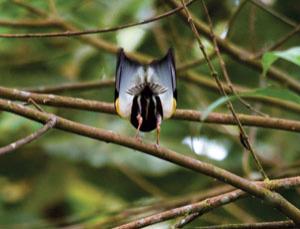CLUB-shaped feathers are no good for flying, but when it comes to courting they can be music to a mate's ears.
The irregular structure of these heavy, specialised feathers is responsible for creating the club-winged manakin's unique high-pitched courtship song, say Kimberly Bostwick and colleagues at Cornell University in Ithaca, New York. The songbird (Machaeropterus deliciosus) uses these feathers for stridulation, a rubbing mechanism commonly used by insects such as crickets.
One feather on each wing has seven ridges along its central vane. The stiff, curved tip of an adjacent feather strikes the ridges every time the bird raises it wings over its back and shakes its feathers. The repeated striking causes adjacent clubbed feathers to vibrate at high speed.
The mechanism was first proposed after viewing slow-motion footage of male courting behaviour. To find out whether the vibrations produced the manakin's mating song, Bostwick's team shook the birds' seven club-shaped secondary feathers at varying rates. Vibrating the sixth and seventh feathers together at 1500 cycles per second produced the correct tone. The other feathers did not produce the noise, suggesting they are instead responsible for radiating the sound (Proceedings of the Royal Society B, DOI: 10.1098/rspb.2009.1576).
Although many insects do this, manakins are unique among vertebrates in using stridulation, says Bostwick.

- New Scientist
- Not just a website!
- Subscribe to New Scientist and get:
- New Scientist magazine delivered to your door
- Unlimited online access to articles from over 500 back issues
- Subscribe Now and Save
If you would like to reuse any content from New Scientist, either in print or online, please contact the syndication department first for permission. New Scientist does not own rights to photos, but there are a variety of licensing options available for use of articles and graphics we own the copyright to.
Have your say
This comment breached our terms of use and has been removed.
It sounds roughly 1500hz so, wouldn't the bird vibrate its wings between 107 cycles per second(using all 7 ridges) and 750(using 1 ridge)?
Interesting. . . .
Thu Nov 12 00:46:37 GMT 2009 by Sam
http://www.dolphinbuddys.com
never heard anything like it. I've seen glow in the dark animals, animals as smart as we are (which sometimes isn't very smart) and knowa heck of a lot about the delphinidae family but never this. cool.
All comments should respect the New Scientist House Rules. If you think a particular comment breaks these rules then please use the "Report" link in that comment to report it to us.
If you are having a technical problem posting a comment, please contact technical support.








